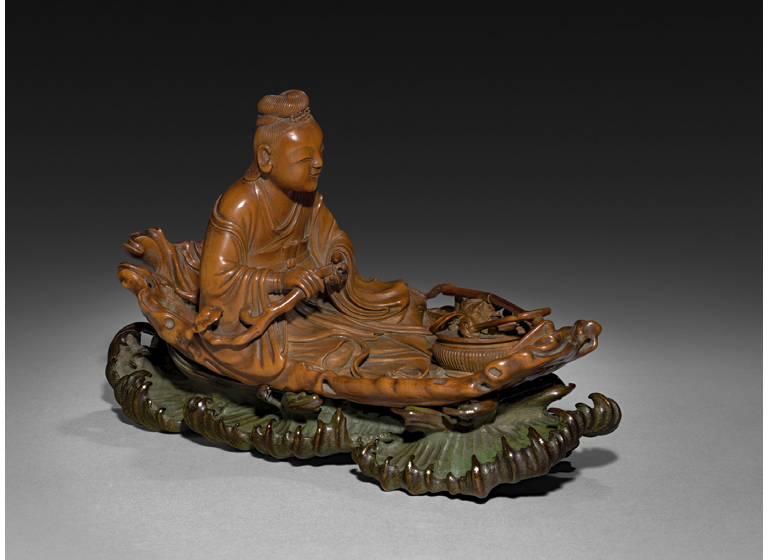“China Through the Magnifying Glass” focuses in on small-scale splendour
Courtesy of The Cleveland Museum of Art
This boxwood figure of Daoist immortal He Xiangu dates back to the 18th century, and is a good example of the intricate craftmanship present in the new Chinese miniatures exhibit at CMA.
February 10, 2023
For better or for worse, modern ethos ascribes success with excess. The world’s tallest building, biggest plane, largest private estate, highest net worth are all well regarded; all these records are symbolic of our collective fascination with surpassing the status quo. The only thing that could usurp the magnetism of the imposing is the near-impossibility of its polar opposite: the miniature. So delicate that it appears to threaten breakage, and yet so perfect in its meticulous composition, the miniature work of art is an enigma. Its very existence serves as a repudiation of expectations and a firm declaration of aesthetic standards. “China through the Magnifying Glass: Masterpieces in Miniature and Detail,” currently on display at the Cleveland Museum of Art, is a triumph of the extraordinary, reveling in the absolute beauty of small-scale craftsmanship within the rich social context of Chinese history from the early beginnings of the Bronze Age up until the 19th century.
“China through the Magnifying Glass” leans heavily upon physicality in both curation and content, guiding viewers in their interpretation of the exhibit’s thesis on the correlation of dimension and visual displays of wealth. The closely grouped exhibit cases enable direct scrutiny of the pieces and their fractional attributes, begging the viewer to reconcile their unconventional size with their functionality. A series of miniscule, brilliantly fashioned snuff bottles line one wall case, each boasting unrivaled techniques in enameling, carving and painting; one particularly fine example, “Snuff Bottle with Stopper” dated to the Qing dynasty (1644-1911 CE), captures a scene of jewel-toned fish swimming through speckled glass, with the current gently rippling over their fins and disturbing the blue grasses around them. Between the bottles is a smooth, leafy green “Thumb Ring”: a descendant of the traditional tool worn for centuries by archers across Asia to better their right-handed grip upon their bow strings. However, the dating of this artifact to the Middle Qing implies its potential use as a symbol of power rather than a sporting aid, as thumb rings were co-opted into popular accouterments indicating social position by civil officials serving in the royal court. How such an article, meant to protect the thumb against abrasions and tension, morphed into a generational symbol of power for the elite class is beyond current understanding, but the historic import of thumb rings suggests that they were viewed as compelling instruments for those who wielded ultimate control.
Nearby, a yellowed fragment of silk is fanned out across a gold bordered support. The aged fabric, once a single leaf within a larger album of hand-painted scenes, bears the likenesses of dozens of children actively engaging in imaginative recreation. Despite presenting as a tableau, “One Hundred Children at Play” actually utilizes the popular motif of childhood joy to bestow key social principles of happiness, good fortune and success upon viewers—particularly young families. The calculated attention to detail in this Southern Song dynasty (1127-1279 CE) work is of impeccable quality: Each child is granted distinguishing features that denote their active presence, whether its kid-sized drums that they beat in discordant time across the garden, courtly-inspired costumes complete with tiny false mustaches or turtle shells and crane feathers that surely factor into a game of elaborate organization. Against the opposite wall of the gallery is a case of Buddhist icons, their size, intricacy and singularity equalling that of the “One Hundred Children.” A gilt bronze of the “Seated Buddha” rests amongst several efficacious representations of his Bodhisattvas—enlightened beings who refrain from achieving transcendence in order to better serve those who seek their guidance. The “Potala Guanyin,” a reclining statue carved from sandalwood during the Five dynasties period (907-960 CE), embodies the likeness of Guanyin, the Bodhisattva of compassion and mercy, in a demeanor and scale that indicates its original purpose as a traveler’s spiritual companion or the centerpiece of a home altar. Guanyin’s shoulders are draped with minute flower garlands still stained with their original red paint while intricate notches emulate the folds of casually laid fabric, further accentuating the Bodhisattva’s welcoming attitude and benevolent nature.
These tokens, small and fashioned with immense care, were once part of much larger lives. Their cultural significance ranges from celebrations of life to exhibitions of wealth, reverence for the community to aesthetic standards. They epitomize the vibrant role of Chinese art in establishing social position and affirming the value of accomplishment. While this exhibit considers the importance of class and image throughout China’s history, it also creates a space in which viewers can admire the craftsmanship of the objects. Their flawless invention and beauty distinguish them from comparable manifestations of aesthetic commentary. “China through the Magnifying Glass: Masterpieces in Miniature and Detail” will remain on display in Gallery 010 until Feb. 26, and is open to the general public.


